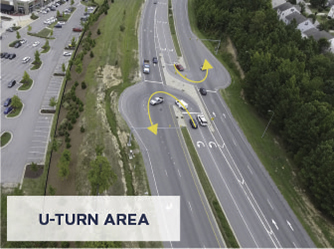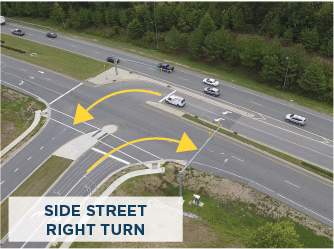Corridors with growing traffic volumes and high crash rates are good candidates for a reduced-conflict intersection.
A reduced conflict intersection – sometimes referred to as a superstreet, a synchronized street or a median U-turn – is a general term used to describe several types of designs that can be used to improve safety and traffic flow on a highway.
There are variations to the designs, but they all function the same by reducing by almost half the number of potential locations, or conflict points, where drivers and pedestrians can collide. As this short video explains, the N.C. Department of Transportation built its first reduced conflict intersection around 2000 in Jackson County, west of Asheville.
Simplifying How Traffic Moves
Examples of Reduced Conflict Intersections


The most common type of reduced conflict intersection design eliminates left turns from side roads onto busy main roads.
Raised medians direct traffic from the side road into turning right. When there is a safe opening in traffic, drivers enter the flow of traffic on the main route. To go the other direction, or cross the highway, they pull into a dedicated lane – typically less than 1,000 feet away – and make a U-turn. There might be a traffic signal at this location.
In cases of dual right-turn lanes from the side road at a signalized intersection, drivers should stay in the left lane, if they intend to make the U-turn once on the main corridor.
Reducing the Risk of Crashes
A traditional four-way intersection has many potential conflict points. Because drivers can go in any direction from all four approaches, the likelihood of a crash is increased.
In 2023, NCDOT's Traffic Safety Unit completed a safety study of 31 reduced conflict intersections that were constructed without traffic signals in North Carolina between 2009-17. The overall results were:
50 percent reduction in total crashes.
80 percent reduction in frontal impact crashes, which are associated with serious injuries and head-on or T-boned collisions.
A 2017 study by the Federal Highway Administration found that reduced conflict intersections with traffic signals reduced crashes 15 percent compared to conventional intersections.
Traveling More Quickly
An intersection with a traffic signal requires several phases to move drivers through the intersection, increasing travel time.
A 2010 study by North Carolina State University conducted for NCDOT found there was an average 20 percent time saving – for all drivers and at any time of the day – using a signalized reduced-conflict intersection compared to a conventional corridor.
Drivers on the minor street who need to turn right and then make a U-turn to travel in their intended direction will require on average 20 more seconds of travel, so side-street drivers receive the benefits of a safer corridor with only a minimal increase in their commute.
Economic Impact of Reduced Conflict Intersections
Economic researchers for the University of North Carolina at Wilmington spent over two years studying more than 400 reduced conflict intersections around the state for a report sponsored by NCDOT and published in 2022.
- While some locations showed a positive and significant increase in economic activity, many others had neither a negative nor positive effect, suggesting the traffic safety benefits gained by the design do not generally harm a business.
- Businesses with a large number of customers and that are busiest later in the day are more likely to believe the design makes it easier for customers to reach them.
- Reduced conflict intersections have the potential to support home values.
Residents and homeowners tended to value the improved traffic flow and traffic safety that result from a reduced conflict intersection, even if they experienced longer wait times to enter the main corridor from a side street without a traffic signal.
Frequently Asked Questions
Reduced conflict intersections and raised medians are innovative solutions to manage access to main roads effectively. They redirect drivers from minor movements. This design lowers crash rates, enhances safety and improves traffic flow, even as traffic volumes increase. NCDOT's goal is to propose the safest and most efficient improvements for communities after careful evaluation of alternatives.
Traditional intersections have numerous locations – called conflict points – where crashes can occur. Because drivers can go in any direction from all four approaches, the likelihood of a crash is increased. A traffic signal also requires multiple phases, leading to delays and longer travel times. This design reduces conflicts, enhances safety and saves time.
While designated U-turn lanes might appear unconventional, they are designed for safety and marked for visibility. Once a driver turns right, the U-turns are typically within 1,000 feet. By taking a right turn first, reaching your destination often becomes quicker and more straightforward than waiting for a safe gap in both directions of traffic. Furthermore, research from N.C. State University in 2010 indicates an overall average time savings of 20 percent using signalized corridors with reduced conflict intersections.
In many areas, it is often difficult and impactful to a community to acquire more land in order to increase the number of travel lanes. In many cases, a reduced conflict intersection can accommodate more traffic nearly as effectively as widening a road without the increased project costs and private property impacts associated with land acquisition.
No, you are not. Reduced conflict intersections have been implemented, either partially or entirely, at over 400 locations across the state. These designs have a demonstrated record of enhancing safety and traffic flow.
Traditional intersections have numerous locations – called conflict points – where crashes can occur. A reduced conflict intersection reduces these conflict points by more than half, significantly decreasing the likelihood of collisions. A 2023 study by NCDOT's Traffic Safety Unit found an overall 50 percent reduction in total crashes after reduced conflict intersections are constructed without traffic signals; the reduction was 80 percent on average for frontal-impact crashes, which often result in serious injuries or deaths.
Left turns contribute to delays at traffic signals, requiring multiple signal phases. The common reduced conflict intersection design redirects minor movement traffic into right turns, which leads to time savings. N.C. State University's 2010 report demonstrates an overall average 20 percent time savings with signalized reduced conflict intersections compared to signalized corridors without them.
NCDOT relies on public feedback to better understand a community’s unique transportation challenges and improve any proposed highway project. A reduced conflict intersection and the designated U-turn areas can be designed to accommodate large trucks and farming equipment and people hauling trailers.
Emergency vehicles using flashing lights and sirens will approach the reduced conflict intersection cautiously, similar to how they approach signalized locations. Emergency vehicles on the major street can go left, through or right directly at a reduced conflict intersection just like a traditional intersection. Safety remains a priority, and measures are in place to ensure efficient emergency vehicle access.
Safe road access is good for business. Customers are more likely to visit businesses on safer corridors with less congestion. A 2006 Federal Highway Administration report confirms that access management projects like reduced conflict intersections have positive impacts on business performance.
An economic impact study for NCDOT was published in 2022 by researchers at the University of North Carolina at Wilmington. The study found the installation of reduced conflict intersections had positive economic effects on some businesses and residential areas. Their analysis involved a combination of data review and surveys. The researchers also relied on a process known as "remote sensing," which uses satellites, special cameras and other equipment to detect commercial, industrial and residential activity before and after a reduced conflict intersection was constructed. The study found:
- While some locations showed a positive increase in economic activity, many others had neither a negative nor positive effect, suggesting the RCI benefits to the traveling public do not generally harm a business.
- The RCI design has the potential to support home values.
In 2010, another statewide study was conducted by researchers at N.C. State University and prepared for NCDOT. The researchers found there was no significant difference in self-reported revenues between businesses on roads with medians versus those without medians. The same survey also found that businesses had a more favorable perception of medians after they were built, and 58 percent of them said the number of their customers rose or stayed the same after the median installation.
Just as a reduced conflict intersection decreases by more than half the number of locations where a collision can occur, the design also dramatically reduces the conflict points for pedestrians and bicyclists. Design elements like marked crosswalks and pedestrian signal boxes simplify their movement. Raised concrete traffic islands offer safer pedestrian crossings within the intersection.